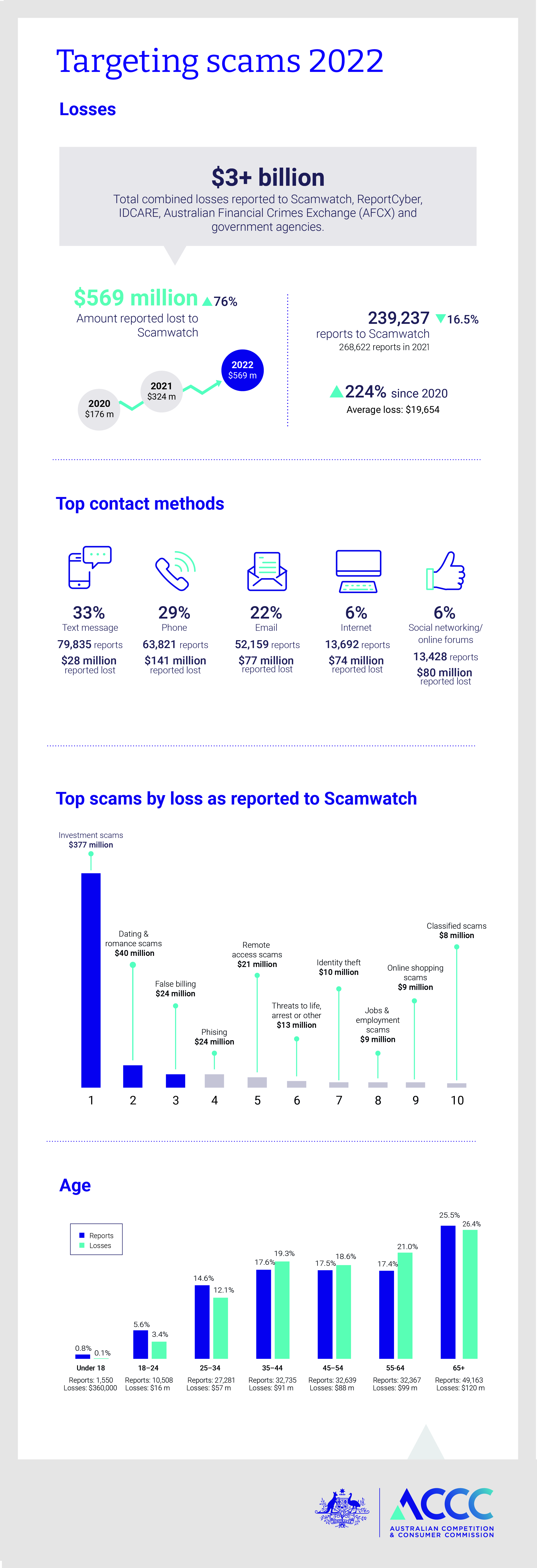Earlier this month, the ACCC released its latest “Targeting Scams” Report, sighting the $3.1 billion lost to scams in Australia during 2022. You can find the report here: ACCC calls for united front as scammers steal over $3bn from Australians | ACCC
Of particular note was the 76 per cent increase in the amount of money lost to scams from the prior year. Whilst the total number of scams reported declined on the previous year, the average financial loss per victim increased by more than 50 per cent. A common misconception is that scams only target older Australians, however people aged 35–44 reported the highest increase in reported losses up 90.7% to $91.2 million.
On the business front, the Scamwatch data shows that small and micro businesses lost $13.7 million to scams in 2022, a 95 per cent increase compared to the previous year. The biggest contributor to these losses were payment redirection scams, also known as business email compromise.
Some other highlights noted in the report:

At Prosperity, protecting our clients’ wealth and data (and our clients’ clients’ wealth and data) is a key pillar of our client service approach. The increasing sophistication, complexity and targeted nature of scams poses a greater risk to us all than any other time in history. In addition to the protocols in place in our interaction with our clients, we recently reflected on how we further assist clients by providing a short reference list of the top five actions you can take as an individual and a business to reduce your likelihood of falling afoul of a scam.
Fundamental to this reference list is a “zero-trust mindset” whereby verifying communications received via text, phone and email is imperative to reducing the risk from scams.
Our top five ways of protecting yourself (and your business) from scams include:
| Personal | Business |
- Be cautious with unsolicited communications: Scammers often reach out to individuals through unsolicited emails, phone calls, text messages, or social media messages. Be wary of any communication from an unknown sender or a sender claiming to be from a legitimate organisation or authority. Always verify the authenticity of such communications (from an independent source) before sharing any personal information or making payments.
- Protect your personal information: Do not share your personal information such as your tax file number, identification document numbers (driver’s license, passport, Medicare etc), bank account information, credit card information, or passwords with anyone unless you are absolutely sure that the person or organisation is legitimate. Be wary of phishing emails or websites that attempt to steal your personal information.
- Use strong passwords: Use strong passwords that are difficult to guess or hack. Avoid using the same password for multiple accounts. Consider using a password manager to securely store and manage your passwords.
- Keep your devices and software up-to-date: Install security updates and patches for your devices and software as soon as they become available. This helps to ensure that your devices and software are protected against the latest security threats.
- Educate yourself: Stay informed about the latest scams and frauds. Research online to learn about common scams and frauds and how to avoid them. Share this knowledge with your family and friends to help them stay safe as well.
| - Train your employees: Educate your employees about common scams and frauds, and provide them with the necessary tools to identify and report suspicious activities. Conduct regular training sessions and drills to keep employees vigilant.
- Implement strong cybersecurity measures: Use up-to-date antivirus and anti-malware software, firewalls, and other security measures to protect your business from cyber threats. Ensure that all devices and software used by your business are regularly updated with the latest security patches. Consider engaging a third party expert to review your current systems and recommend improvements.
- Verify credentials: Before doing business with a new vendor or supplier, verify their credentials and conduct background checks to ensure that they are legitimate. Be wary of unsolicited offers or requests for sensitive information. Suppliers appreciate being paid correctly and generally welcome these checks, so don’t hesitate to make the call!
- Use secure payment methods: Only use secure payment methods to protect your business from fraud. Avoid using wire transfers, crypto-currency or other payment methods that are difficult to trace or recover. Consider any security gaps in your payment process and the way data is transferred from a supplier invoice, to your accounting system and then to online banking system.
- Create a culture of transparency and accountability: Encourage open communication and transparency within your business, and ensure that employees are aware of their responsibilities to protect the business from fraud. Have clear policies and procedures in place for reporting suspicious activities, and ensure that all employees are aware of these policies.
|
If you have any questions regarding the above, contact Director of Corporate Assurance Alex Hardy at ahardy@prosperity.com.au.

